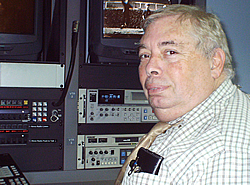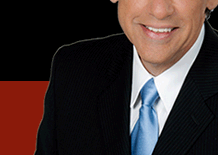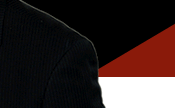
|
Weekly
Features
The Other Side of the Control Room Glass |
 Bill
Pasternak, (ham radio call letters WA6ITF), is an oddity in
our profession: a Broadcast Engineer who can write outside of
the realm of technical publications. He works as a Broadcast
Engineer with KTTV Fox 11 / UPN 13 Television in Los Angeles
and private Broadcast Consultant specializing in the design
of video post production facilities. He is the co-founder and
Managing Editor of the all-volunteer Amateur Radio Newsline(tm)
bulletin service and Creator/ Administrator of the annual “ARNewsline(tm)
Young Ham of the Year Award” program. He is the author
of three books, production staff member to several educational
films and videos including Co-Producer of the award winning
“Amateur Radio Today,” authored the “Looking
West” column for 73 Amateur Radio Today Magazine for 26
years, currently writes the monthly “VHF, FM and Repeater”
column for Worldradio Magazine, is a contributing writer to
several broadcast trade publications and is a frequent contributor
to CQ Magazine. He is a member of the ARRL, Radio Club of America
and Quarter Century Wireless Association as well as a founding
member of the Hollywood Hills QRP Contest Club. Bill is the
only person ever chosen to be recipient of both the prestigious
Dayton Amateur Radio Association’s “Specific Achievement”
(1981) and “Radio Amateur of the Year” (1989) awards.
He also was presented the ARRL National Certificate of Merit
(1995) in recognition of his contributions to the “furtherance
of the goals of the Amateur Radio Service.” Bill and his
wife Sharon (KD6EPW) reside in Santa Clarita California with
their two “puppy people” and can be reached by e-mail
to billwa6itf@aol.com
or wa6itf@arnewsline.org. Bill
Pasternak, (ham radio call letters WA6ITF), is an oddity in
our profession: a Broadcast Engineer who can write outside of
the realm of technical publications. He works as a Broadcast
Engineer with KTTV Fox 11 / UPN 13 Television in Los Angeles
and private Broadcast Consultant specializing in the design
of video post production facilities. He is the co-founder and
Managing Editor of the all-volunteer Amateur Radio Newsline(tm)
bulletin service and Creator/ Administrator of the annual “ARNewsline(tm)
Young Ham of the Year Award” program. He is the author
of three books, production staff member to several educational
films and videos including Co-Producer of the award winning
“Amateur Radio Today,” authored the “Looking
West” column for 73 Amateur Radio Today Magazine for 26
years, currently writes the monthly “VHF, FM and Repeater”
column for Worldradio Magazine, is a contributing writer to
several broadcast trade publications and is a frequent contributor
to CQ Magazine. He is a member of the ARRL, Radio Club of America
and Quarter Century Wireless Association as well as a founding
member of the Hollywood Hills QRP Contest Club. Bill is the
only person ever chosen to be recipient of both the prestigious
Dayton Amateur Radio Association’s “Specific Achievement”
(1981) and “Radio Amateur of the Year” (1989) awards.
He also was presented the ARRL National Certificate of Merit
(1995) in recognition of his contributions to the “furtherance
of the goals of the Amateur Radio Service.” Bill and his
wife Sharon (KD6EPW) reside in Santa Clarita California with
their two “puppy people” and can be reached by e-mail
to billwa6itf@aol.com
or wa6itf@arnewsline.org.
|
|
|
SAYING GOODBYE - Part 1
 How
do you say goodbye to a someone who was a lot more than just
a friend? How do you accept the news that the person you spoke
with on the phone only as few days earlier, won’t ever
be there again? Most important, how do you honor such a person
past you’re own remembrances? These were the questions
that came into sharp focus last August 15th when word reached
me that my friend and mentor of the last three decades had crossed
over to the other side of the “great ethereal abyss.”
When I write for you the name “Roy Neal,” most of
you will immediately associate it with NBC Network News. And
rightly so. As a Producer and “science correspondent,”
Roy covered the space program extensively for NBC, particularly
the Mercury, Gemini, Apollo programs and the numerous Space
Shuttle missions. He was personal friends of many of the pioneering
space travelers, particularly the Mercury 7 astronauts and served
with the Mercury 7 Foundation. But there was another side to
Roy Neal that only a handful of you may know about. That being
his hobby of Amateur Radio that not only played a major role
in his life, but impacted on many others around the world, including
this writer. How
do you say goodbye to a someone who was a lot more than just
a friend? How do you accept the news that the person you spoke
with on the phone only as few days earlier, won’t ever
be there again? Most important, how do you honor such a person
past you’re own remembrances? These were the questions
that came into sharp focus last August 15th when word reached
me that my friend and mentor of the last three decades had crossed
over to the other side of the “great ethereal abyss.”
When I write for you the name “Roy Neal,” most of
you will immediately associate it with NBC Network News. And
rightly so. As a Producer and “science correspondent,”
Roy covered the space program extensively for NBC, particularly
the Mercury, Gemini, Apollo programs and the numerous Space
Shuttle missions. He was personal friends of many of the pioneering
space travelers, particularly the Mercury 7 astronauts and served
with the Mercury 7 Foundation. But there was another side to
Roy Neal that only a handful of you may know about. That being
his hobby of Amateur Radio that not only played a major role
in his life, but impacted on many others around the world, including
this writer.
You see, Roy Neal, as K6DUE - the “ham radio operator “
was the person who made it possible for kids in classrooms world-wide
to talk directly to Astronauts and Cosmonauts “on-orbit”
without the need to use NASA communications channels. Simply
said, Roy was the father of two programs developed to achieve
that goal: SAREX - The Shuttle Amateur Radio Experiment and
-- later ARISS -- Amateur Radio on the International Space Station.
For me to properly explain the importance of this in Roy’s
life and even why I am writing about it, I must digress for
a moment and provide you with a bit of personal history. It
goes back to the late 1950’s. I was a teenager attending
Lafayette High School in Brooklyn New York.
One of my closest friends was a guy named Henry Feinberg who
just happened to have an FCC suffix to his name in the form
of ham radio call letters K2SSQ. While in our senior year, Henry
landed a job on the popular kids science show “Watch Mr.
Wizard.” Today we take broadcast tape delayed for granted.
Back then, AMPEX Corp. was still a year or two from introducing
its first black and white 2” Quad machine. “Delayed
broadcasts” in that era meant either doing the show live
for each time zone or having the television picture recorded
on 16 millimeter film through a process only a few of us remember
called Kinescope. “Watch Mr. Wizard” was done live
to the Eastern time zone and recorded on film for broadcast
elsewhere at a later time. And so it was that one Saturday afternoon
I got “invited” to see a live broadcast of the show.
After the show, I was taken for a behind-the-scenes tour of
NBC’s 30 Rockefeller Plaza facility. While walking down
one of the halls we saw a person I immediately recognized from
that networks coverage of a recent missile launch. I boldly
went where no kid should have gone and said: “Hello.”
And so it was that at age 17 I met a man whose career would
come to inspire me in later life. My next encounter with Roy
came in 1972 By now I was grown up, married and had relocated
to the City of Angels. And along the way I had gotten my ham
radio license with the call letters WA2HVK.
On arrival in “LaLa Land” I conformed to me government
mandate of the day and applied for new call letters to indicate
my SoCal residence. The FCC handed me WA6ITF -- the call sign
I still possess to this day. We were living in Panorama City
at the time. One evening I turned on my ham radio set to hear
a very familiar voice. One I had heard earlier I n the day issuing
forth from the loudspeaker of our aging Sylvania color TV set.
(Anyone else remember Sylvania television sets with “Halo-Light?”)
Here on the ham radio set he had put out what we hams call a
“CQ” -- a general call which really is akin to saying:
“...hello out there in radio land. Is there anyone who
wants to talk to me?” Knowing the voice and remembering
how nice a person he was from our brief encounter at NBC in
New York I responded. I had no idea that in doing so, this would
be a true crossroads in both of our lives. And here’s where
the chain of events is such as to make you wonder if ones life
is not really pre-destined. To explain this, I must difgress.
Prior to our leaving New York, I was approached by the editor
of a magazine called “73 Amateur Radio” to write a
story about our relocation and the people I spoke to on the
ham radio while driving cross-country. That article never was
published but it led to a 26 year career writing a column about
ham radio on the West Coast for the same magazine. This in turn
lead to my meeting film maker Dave Bell whose ham radio call
letters are W6AQ.
And so it was that in early 1973 Dave asked me to provide some
input to a promotional movie he was making about the hobby.
As luck would have it, his on-screen talent would be Roy Neal.
It would be the first of many such film and video associations
between the three of us. Ill describe some in depth in future
columns. In 1977, another ham radio friend by the name of Jim
Hendershot (call letters WA6VQP) decided that what the hobby
needed was its own news and information service. Not being one
to sit on his laurels, Jim went out and set up the “Westlink
Radio Network” and brought me along for the ride. In this
case the term “network” was a bit misleading because
the beginnings of the news service was really Jim reading the
script he had written onto tape, handing the cassette to a friend
who would drive to the top of a local hill and broadcast it
from his mobile radio on a frequency that most ham, radio operators
had no way to hear! (223. 500 MHz in the then under-utilized
1 1/4 meter band.)
Each week I would supply Jim with many of the stories (after
all I was now into my 5th year as a writer for 73 Magazine)
and he would produce a 30 minute newscast to be broadcast from
that hilltop overlooking the San Fernando Valley. Eventually
ham operators in other parts of the United States found out
about about “Westlink,” and in short order Jim was
in the tape duplication and mailout business -- so as to speak.
And it remained that way for about a year until Jim decided
to relocate. He called to ask if I wanted to take over “Westlink.”
I said: “OK,” but only if I could find people to help
me. In short order I did in the personage of Bill Orenstein
(ham radio call KH6IAF back then - now KH6QX) who was an audio
engineer at the NBC Network and his friend Alan Kaul (W6RCL)
then a newswriter at KNBC. For our first attempt, I supplied
the stories. I think Al rewrote them into a script and another
friend -- the late Zeke Manners (the original Beverly Hillbilly)
recorded it for us. Even though it had a rather limited audience
(we had substituted a Collins cart machine with a “magic
black box” I devised to make it auto connect to a phone
line for duplicating and mailing out tapes) the popularity of
the “Westlink News” among ham radio operators grew
quickly. Alan soon became its primary anchor, soon sharing the
mic from the Wollensak recorder with “Big Jim” Davis
(ham call letter then WA2CCY - now W2JKD) who had come to town
as the Program Director at KMPC.
Roy also was a part of our little group early-on, but he could
not lend his voice to the newscasts due to contractual obligations.
But he soon became my personal mentor. I remember visiting him
one afternoon and him saying: “Old buddy, its about time
you learned how to write a news story.” He then proceeded
to teach me to put who, what, when, where and how into the first
sentence. 1979 saw us Roy, Dave and myself united once again
for Dave’s award winning “The World of Amateur Radio.”
And what a world this movie was. A trip of fact that no flight
of fantasy could equal. A movie that not only showed the hobby
here in the U.S., but highlighted it world-wide and included
such notables as the late Barry M. Goldwater (K7UGA) and H.M.
King Hussein of Jordan (JY1). Ill bet that most of you were
unaware that the former ruler of that middle-Eastern nation
took time out of his hectic schedule to sit on the radio and
talk to the public of the world! It was not long after that
the idea to put a ham radio station into space hit Roy. Actually,
he had discussed the idea years earlier with his friend and
NASA Astronaut Owen Garriott (ham call letters W5LFL) when the
latter was scheduled to fly on “Skylab.” NASA said
“no” to that one, but neither Roy nor Dr. Garriott
were ready to write off the idea. When NASA assigned Garriott
to be a crew member for the STS-9 flight the idea of a ham radio
operator on the air from an orbiting space shuttle took root.
It would be Roy Neal who would make it happen and who would
document it on video for the world to see. (To be continued)
|
|
|
|
|
|
|

















